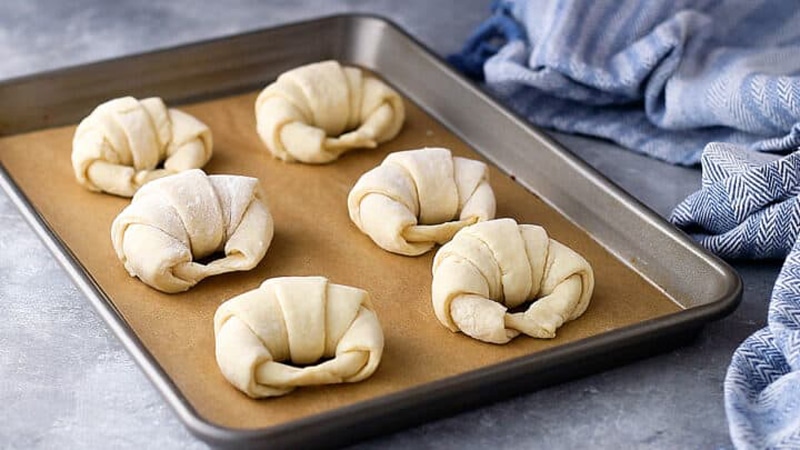Have you ever dreamed of baking your own batch of fresh, flaky croissants? Look no further! In this beginner’s guide, rdcbraille will take you through the step-by-step process of making homemade croissants that are sure to impress your family and friends. From preparing the dough to achieving the perfect golden-brown crust, we’ve got you covered. So let’s dive in and unlock the secrets to creating these delightful pastries from the comfort of your own kitchen.
Understanding the Art of Croissant Making
Before we embark on our croissant-making journey, it’s important to understand the art behind these delectable pastries. Croissants are a type of viennoiserie pastry known for their light and flaky texture. They originated in France and have since become a beloved treat worldwide. The key to achieving the perfect croissant lies in the precise balance of buttery layers and a crisp exterior. So let’s get started on our delicious adventure!
Gathering the Ingredients
To make homemade croissants, you will need the following ingredients:
- All-purpose flour
- Unsalted butter
- Sugar
- Salt
- Active dry yeast
- Milk
- Water
Make sure to gather all the ingredients before you begin, as it will save you time and ensure a smooth baking process.
Mixing the Dough
- In a large mixing bowl, combine the all-purpose flour, sugar, salt, and active dry yeast.
- In a separate saucepan, warm the milk and water until it reaches a temperature of around 110°F (43°C).
- Pour the warm milk and water mixture into the bowl with the dry ingredients.
- Stir the mixture until a shaggy dough forms.
- Transfer the dough to a lightly floured surface and knead it for about 5 minutes until it becomes smooth and elastic.
Incorporating the Butter Block
- Roll out the dough into a rectangular shape, approximately 1/4 inch thick.
- Place the unsalted butter between two sheets of parchment paper and pound it with a rolling pin to soften it.
- Remove the top parchment paper and place the butter block onto the center of the rolled-out dough.
- Fold the edges of the dough over the butter, completely enclosing it.
- Roll out the dough-butter combination into a long rectangle, approximately 1/4 inch thick.
Folding and Resting the Dough
- Fold the dough into thirds, similar to folding a letter.
- Rotate the dough 90 degrees and roll it out again into a long rectangle.
- Repeat the folding process two more times, ensuring that you rotate the dough between each fold.
- After the final fold, wrap the dough in plastic wrap and refrigerate it for at least 1 hour to allow the gluten to relax and the butter to solidify.
Shaping the Croissants
- Remove the chilled dough from the refrigerator and roll it out into a large rectangle, approximately 1/4 inch thick.
- Using a sharp knife or a pizza cutter, trim the edges of the dough to create clean lines.
- Cut the dough into triangles, with each base measuring around 4-5 inches wide.
- Make a small slit in the base of each triangle and gently roll it towards the tip, shaping it into a crescent.
- Place the shaped croissants on a baking sheet lined with parchment paper, leaving enough space between them for expansion.
Proofing the Croissants
- Cover the baking sheet with a clean kitchen towel and let the croissants proof in a warm, draft-free area for approximately 2-3 hours, or until they double in size.
- To create a warm proofing environment, you can preheat your oven to its lowest temperature for a few minutes, then turn it off before placing the croissants inside.
Baking to Perfection
- Preheat your oven to 400°F (200°C).
- In a small bowl, beat an egg and brush it lightly over the proofed croissants. This will give them a beautiful golden-brown color.
- Place the baking sheet in the preheated oven and bake the croissants for 15-20 minutes, or until they turn golden brown and flaky.
Cooling and Enjoying
- Once the croissants are baked to perfection, remove them from the oven and allow them to cool on a wire rack for a few minutes.
- Serve the croissants warm or at room temperature and enjoy their buttery, flaky goodness. They pair perfectly with a cup of hot coffee or tea.
Troubleshooting Tips
- If the dough is too sticky, sprinkle a small amount of flour and knead it until it reaches the desired consistency.
- If the butter starts to melt while rolling the dough, place it in the refrigerator for a few minutes to firm up before continuing.
- If the croissants don’t rise during proofing, ensure that the area is warm enough for yeast activation. You can also try extending the proofing time.
Variations to Try
While classic croissants are a treat on their own, you can also experiment with different flavors and fillings. Here are a few variations to consider:
- Chocolate Croissants: Place a piece of dark chocolate at the base of each triangle before rolling and shaping the croissants.
- Almond Croissants: Fill the croissants with almond paste and top them with sliced almonds before baking.
- Ham and Cheese Croissants: Add a slice of ham and a sprinkle of shredded cheese to each croissant before shaping them.
Feel free to unleash your creativity and customize your croissants according to your taste preferences.
Storing Homemade Croissants
If you have leftovers or want to make the croissants in advance, here’s how you can store them:
- Allow the croissants to cool completely.
- Place them in an airtight container or a resealable plastic bag.
- Store them at room temperature for up to 2 days or in the refrigerator for up to 5 days.
- To reheat, simply warm them in a preheated oven at 350°F (175°C) for a few minutes until they are heated through.
Frequently Asked Questions (FAQs)
Q1: Can I use instant yeast instead of active dry yeast?
Yes, you can substitute instant yeast for active dry yeast in the same quantity. However, you may need to adjust the proofing time as instant yeast tends to work faster.
Q2: Can I freeze the croissant dough for later use?
Absolutely! After incorporating the butter block, you can tightly wrap the dough in plastic wrap and freeze it for up to 2 months. Thaw it overnight in the refrigerator before continuing with the shaping and baking process.
Q3: How can I make my croissants extra flaky?
To achieve maximum flakiness, make sure to roll the dough and butter block evenly, and be diligent with the folding process. Additionally, using high-quality butter with a higher fat content can enhance the flakiness of the croissants.
Q4: Can I make mini croissants instead of the regular-sized ones?
Yes, you can make smaller croissants by cutting smaller triangles and adjusting the baking time accordingly. Keep in mind that mini croissants may require less time in the oven.
Q5: Can I freeze the baked croissants?
Yes, you can freeze the baked croissants. Allow them to cool completely, then place them in a freezer-safe container or bag. When ready to enjoy, simply thaw them at room temperature or reheat them in the oven.
Conclusion
Congratulations! You have successfully completed your journey through this beginner’s guide to homemade croissants. By following the step-by-step instructions, you’ve mastered the art of creating buttery, flaky croissants that will impress anyone who takes a bite. So put on your apron, gather your ingredients, and start baking. Get ready to savor the heavenly aroma and enjoy the delightful taste of your own homemade croissants.







